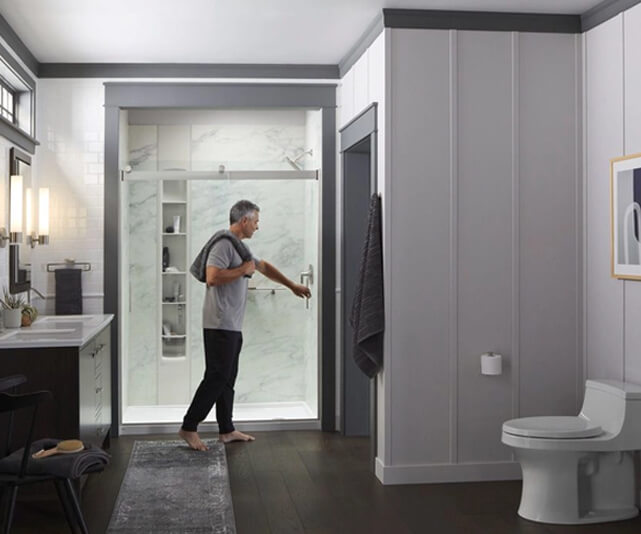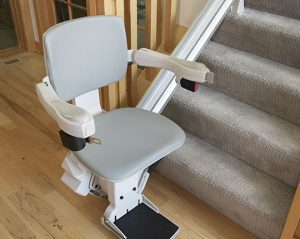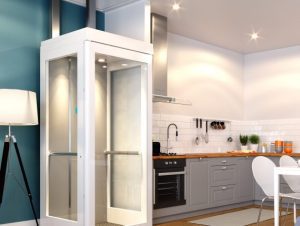Finding the right access lift or elevator for your home can be overwhelming. Many homeowners need a safe way to move between floors. Our article provides an easy guide to selecting the perfect solution for your needs.
Keep reading for insights and options.
The Importance of Accessibility in the Home
Moving from the basics, we now focus on why making your home accessible is crucial. Home accessibility not only supports individuals with mobility challenges but also enhances the overall safety and functionality of your living space.
Installing a residential elevator or other mobility solutions can transform your property into a safer, more inclusive environment. This move addresses accessibility challenges head-on, ensuring everyone in the household can navigate through different areas of the home with ease.
Accessibility improvements like residential elevators are smart investments that boost your property’s market value. They signal to potential buyers that your home caters to diverse needs and prioritizes safety for all its residents.
Moreover, such upgrades offer peace of mind knowing that your house adapts to changing mobility requirements over time, making it an ideal long-term investment for both comfort and financial gain.
Upgrading with these features showcases foresight in property enhancement and commitment to creating a universally welcoming space.
Types of Access Lifts and Elevators
Exploring the different types of access lifts and elevators opens up a world of possibilities for making your home more accessible. From sleek home elevator systems to practical wheelchair lifts, each option offers unique benefits that cater to various needs and spaces.
Home Elevator Systems
Home elevator systems offer a sleek solution for vertical transportation in your house, combining elegance with practicality. These elevators come in various types such as hydraulic elevators, machine room-less elevators, winding drum elevators, shaftless elevators, and vacuum elevators.
Each type has its own unique advantages and can fit into different home designs and spaces. By installing a residential elevator, you not only boost the value of your home but also enjoy the convenience it brings to daily life.
Choosing the right elevator involves understanding these different systems. Hydraulic elevators are known for their smooth operation and reliability. Machine room-less options save space by eliminating the need for a separate machine room.
Winding drum and shaftless models provide efficient solutions that require less structural modification to your home. For a futuristic touch with minimal installation work, vacuum elevators use air pressure to move between floors gently yet swiftly—no cables or pits needed.
This array of choices lets homeowners find an access lift that perfectly matches their mobility needs while enhancing their home’s accessibility and style.
Wheelchair Lifts
Wheelchair lifts offer a practical solution for enhancing home accessibility without the extensive space and budget requirements of traditional elevators. They provide an efficient way for people with mobility limitations and their companions to move between different levels of a house.
With two primary types available, vertical platform lifts operate similarly to elevators by moving straight up and down, while inclined platform lifts follow the path of existing staircases.
Both are designed with safety and convenience in mind, making them a reliable choice for improving wheelchair accessibility within homes.
Choosing between vertical and inclined wheelchair lifts depends on the specific layout and space constraints of your property. Vertical lifts require less horizontal space, making them suitable for tight spots where preserving floor area is crucial.
In contrast, inclined lifts work well with staircases, offering a seamless integration without significant structural alterations. Each style enhances companion accessibility alongside the user, ensuring everyone can benefit from improved access throughout the home.
With considerations like these in mind, homeowners can select the most appropriate type of wheelchair lift to meet their needs and elevate their quality of life.
Stair Lifts
Stair lifts offer an affordable mobility solution, making them a great choice for families on a budget. The cost of installing a stair lift can vary, depending on the user’s body size and the staircase’s design and location in the home.
Top brands like Lifeway Mobility, Bruno, and Stannah provide reliable options that cater to different needs.
Choosing the right stair lift requires considering several factors such as the user’s mobility needs, staircase layout, and weight capacity. These accessible devices ensure users can safely navigate between floors without modifying their homes extensively.
With models designed to fit various types of staircases including straight or curved paths, stair lifts enhance home accessibility efficiently.
Dumbwaiters
Dumbwaiters make moving meals, laundry, or other items between floors in your home a breeze. These small freight elevators use cable pulley systems or hydraulic lifts to carry goods, not people.
They have become smarter and more efficient over time. Originally found in mansions and restaurants for transporting materials, dumbwaiters now offer a safe and economical solution for homeowners.
This type of lift is ideal for those looking to add convenience without the space requirements of residential elevators. The evolution from basic hoist mechanisms to advanced mobility solutions means dumbwaiters are an excellent choice for material transport within modern homes.
Next up, let’s explore Material Lifts as another option for your home accessibility needs.
Material Lifts
Material lifts serve as a practical solution for homeowners looking to transport items like groceries, laundry, or heavy furniture between different floors in their home. These lifts offer the convenience of moving goods effortlessly, avoiding the strain and risk associated with carrying items up and down stairs.
Equipped with safety features that comply with regulations for residential use, material lifts ensure a secure way to handle everyday tasks.
Homeowners can install these handy devices in various locations throughout their residence, adding flexibility to their living spaces. Operating independently, material lifts boost individuals’ independence by simplifying tasks that would otherwise require physical effort or assistance.
From groceries to bulky objects, these elevators make transporting items within a home both safe and straightforward.
Factors to Consider When Choosing an Access Lift or Elevator
Selecting the right access lift or elevator for your home means considering what you really need and how much space you have. You’ll want to assess safety features closely and figure out what fits within your budget.
Mobility needs
Evaluating the mobility needs of individuals using the lift is a critical first step before installing any home accessibility solutions. Different lifts cater to specific requirements, such as vertical platform lifts for wheelchair users who need to move straight up and down between floors or inclined platform lifts that offer similar benefits but follow the path of an existing staircase.
This makes it crucial to understand whether a resident requires support for walking up stairs, sitting assistance, or full wheelchair accessibility.
Choosing between stairlifts, power chair lifts, or any other home mobility devices involves considering both current and potential future needs. A person’s mobility can change over time, so selecting a solution that can adapt to varying levels of ability ensures long-term usefulness and value from the investment in home accessibility.
This approach not only improves independence within the home but also contributes positively towards making living spaces comfortable and safe for everyone.
Space availability
Checking the space in your home is a must before picking an access lift or elevator. You need to ensure there’s enough room, not just for the elevator or lift itself but also for essential components like shafts and doorways.
Space constraints can significantly influence both the cost and how long installation takes. It’s all about balancing what you need with what’s physically possible in your home.
Also, think about who will use the access lift or elevator. Wheelchair users and others who rely on mobility devices need enough space to move comfortably in and out of these installations.
This means considering doorway clearance, elevator dimensions, and whether there’s room for turning wheelchairs inside. Overlooking these details might limit accessibility, making it crucial to factor them into your planning from the start.
Safety features
Safety features play a crucial role in the choice of access lifts and elevators for your home. Elevator door interlocks prevent accidental access to the shaft, ensuring user safety at all times.
Compliance with safety regulations guarantees that your elevator meets the highest standards of security and efficiency. Also, incorporating smart technology into your home lift system can significantly enhance its safety measures.
Manufacturers equip home elevators with advanced access control systems, allowing you to restrict entry to certain floors or limit elevator use to specific times. This feature adds an extra layer of security to your home by preventing unauthorized use.
To ensure a safe and smooth ride for all users, it’s essential that your chosen elevator includes smooth ride assurance technologies alongside these enhanced security measures.
Budget
Setting a budget for your home lift or elevator is crucial. The price varies based on different factors such as the elevator model, installation location, and how long the installation takes.
Knowing these variables helps in planning how much money to set aside.
Choosing an accessibility lift involves looking at more than just initial costs. Think about lift budget including the cost of maintenance over time. Opting for a wheelchair lift or vertical platform lift might suit smaller budgets better than full residential elevators do.
It’s essential to match your needs with what you can afford without compromising on safety or necessary features.
Benefits of Access Lifts and Elevators
Access lifts and elevators offer more than just convenience for homeowners. They bring freedom and a better lifestyle to those facing mobility challenges, enabling them to move around their homes safely and effortlessly.
Increased independence
Installing an access lift or elevator at home can dramatically increase independence for individuals with mobility limitations. It allows seniors, people with disabilities, and those aging in place to move freely around their homes without relying on others.
This independence boosts self-confidence and promotes a barrier-free living environment.
Having these mobility aids in the home not only supports independent living but also ensures safety and comfort. Individuals can safely navigate between floors, reducing the risk of falls and injuries.
Elevators and lifts signify a step towards transforming one’s living space into a fully accessible, comfortable haven that supports aging gracefully and independently.
Improved home value
Investing in residential elevators or accessibility lifts not only boosts your home’s functionality but also enhances its market value. Homes equipped with such mobility solutions often fetch a higher price per square foot on the real estate market, as confirmed by data from the National Association of Realtors (NAR).
These improvements appeal to a broader range of buyers, especially those interested in aging in place or universal design concepts, making your property stand out.
Adding these features can be seen as a smart investment for homeowners looking to increase their property value enhancement while providing practical benefits. They create more usable space within the home and cater to future-proofing needs, appealing to families and individuals who foresee long-term habitation.
This foresight not only enriches daily living through improved multilevel home access but positions your property as a valuable asset should you decide to sell.
Ease of moving objects and furniture
Beyond enhancing your home’s value, access lifts and elevators significantly simplify the task of moving objects and furniture. Homeowners can easily transport heavy items to different floors without strain or risk of injury.
This advantage is invaluable for families looking to rearrange their living spaces or when introducing new furnishings into the home.
Elevators and lifts provide a secure, efficient solution for transporting groceries, large belongings, or bulky furniture pieces. They eliminate the hassle associated with carrying cumbersome items up and down stairs, making it convenient to refresh your interior décor or manage day-to-day tasks that involve moving objects around your residence.
Safety and convenience for those with mobility limitations
After considering how access lifts and elevators facilitate the movement of objects and furniture, it’s clear they also play a crucial role in ensuring safety and convenience for individuals with mobility limitations.
Home elevators, for example, offer a secure way to navigate between floors without the risks associated with stairs. This proves especially beneficial for those who find stairs challenging due to disability or aging.
Wheelchair lifts are another essential assistive technology, providing an accessible solution that fosters independence within the home environment. They allow users to overcome barriers to free access in multi-level homes easily.
For every homeowner contemplating home modifications for accessibility purposes, these innovations represent not just improvements in property value but vital enhancements in quality of life for people facing mobility challenges.
Customization options
Customization options for access lifts and elevators offer homeowners the chance to match these essential features with the unique style and requirements of their homes. You can choose from a wide range of personalized accessibility solutions, including customizable elevator features, individualized lift options, and custom-designed access lifts.
This flexibility ensures that your home not only gains an efficient mobility solution but also an aesthetic enhancement that boosts its value.
Selecting the right bespoke home elevators involves considering various car styles, accessories, and configurations. Access Elevator presents numerous possibilities to create a custom system tailored to fit your space perfectly and meet all your needs.
With these personalized systems, you add both functionality and style to your home, making it more desirable while ensuring it caters to everyone’s mobility needs effectively.
Contact Caliber Home Solutions for Your Home
Accessibility in your home transforms lives, ensuring everyone can move freely. From stairlifts to residential elevators, a variety of options cater to specific needs. Picture installing an access lift and the newfound independence it brings.
Let’s make homes more welcoming for everyone through smart accessibility enhancements. Contact us today to get started!
FAQs
1. What types of access lifts and elevators are available for homes?
There are various types including stairlifts, platform lifts, and residential elevators to fit different home needs.
2. Can an elevator be installed in any type of home?
Yes, elevators can be customized to fit most types of homes, but it may require some structural modifications.
3. How much space do I need for a home elevator or lift?
The space needed depends on the type of lift or elevator; stairlifts need less space than full-sized elevators.
4. Are home elevators safe?
Yes, when installed correctly by professionals and maintained regularly, home elevators are very safe.
5. How much does it cost to install an access lift or elevator in my home?
Cost varies widely based on the type of lift, customization options, and installation requirements; getting a quote from providers is best for accurate pricing.




